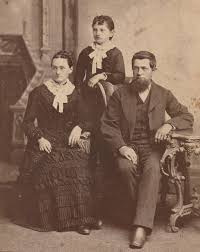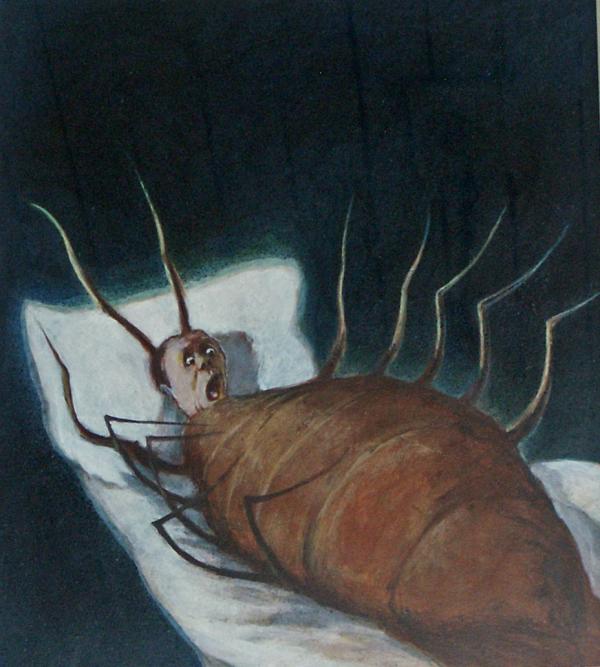Read Berkoff’s essay in the script called ‘Stage Setting’
In paragraph 2, he writes, “I chose to direct…” to “reminiscent of old prints.”
What do you this all this means? Discuss and Define: ‘formal, fixed attitudes’ choreographed reactions, Victorian gestures, old prints’. RECORD THIS QUOTE IN YOUR JOURNAL
Can you stage the opening so that after EACH character has come on and established their ‘small mime’ they come together to form a “formal…old print” like a Victorian photograph.

Now create a ‘photo’ of what the characters really deep down feel about each other – a ‘mie’ (frozen image – heightened and exaggerated – that reveals the inner feelings or inner dynamics within the Samsa family.)
Now rehearse the TRANSFORMATION from formal print to mie and back to formal print –
What would the audience understand after seeing this?
SEE BLOG ON ‘MIE’
This short film give you some idea of the Japanese theatre form.
Take note of the phrase “stylised realism” – can this be applied to Berkoff?
Word count 400 words
Essay style question: As the Director explain and justify how you would stage the opening two pages (P79/80) to reveal your understanding of a Berkovian style.
[You can include the above ‘photo’ exercise, work you’ve done on establishing each characters through posture, walk and action mime, the creation of a composite ‘bug’ by all the 4 main actors]
2) Read Berkoff’s essay in the script called ‘Steven Berkoff on Metamorphosis’. On page 2 he writes, “The family, living in fear…became “animated marionettes”…’
In paragraph 2 he writes, “I chose to direct…” to “reminiscent of old prints.” What do you this all this means? Define ‘formal, fixed attitudes’ choreographed reactions, Victorian gestures, old prints’. RECORD THIS QUOTE IN YOUR JOURNAL
View the clip at 03:35 to get an idea of the ‘style’ described by Berkoff as ‘animated marionettes’.
Word bank to use:
action mime, staccato {jerky} movement, “animated Marionettes”, slow motion (lyrical – smooth – seamless) , heightened /exaggerated characterisation, tableau or freeze frames, mie, narrative voice, character voice, tone, direct address, 3rd person narration, contrapuntal speaking, split stage, cross-cutting, chorus work, sound effects by actors,
USE QUOTES FROM THE STAGE DIRECTIONS Eg: “In time to the ticking” or “resembling automatic figures in a wax-work”.
Paragraph structure: Statement (director’s aim) What will it look like? How will the actors do it? Why this idea works (link to aim, Berkovian style, the question, audience response).
Quotes from the film clip:
“so they became like mechanical dolls – eating away. Why I wanted to make it mechanical was that when the beetle wakes up he also is in a sense mechanical.”
“I used this idea of mechanistic, robotic theatre because by changing the rhythm of what we see in naturalism, we make people re-look at people.”
Try and work these into any writing that you do. It will show wider research skills and can act as ‘Justification’ for WHY you are suggesting things should be done in a particular way.
Watch the whole film clip of Berkoff on Mime and hear how a course in Mime in Paris in 1965 shaped his ideas about how the body could be used in theatre (ideas which were radical in the UK in the 1960s – 80s. Now it’s more mainstream and accepted).
Essay style question: How would you direct the text and action on P81-84 to reinforce the idea that this play is non-naturalistic?
SAMPLE PARAGRAPH (Explain and Justify structure).
My aim, as director, would be to show the Samsa’s breakfast routine as a monotonous activity that they do without thinking every day
I’d have each family member sit on their stools down stage (except Gregor who is still up stage in his room) eating breakfast using action mime to suggest the food, drink and table.
Mr Samsa will stab at a sausage in a staccato rhythm, making big movements, Mrs Samsa will dap her napkin to her mouth, Greta will make small bird-like movements lifting a cup of tea to her lips.
Berkoff has said in interview that he chooses sometimes to direct his actors in a robotic and mechanistic way, “because by changing the rhythm of what we see in naturalism, we make people re-look at people.” By using this technique for this meal, it would remind the audience that this is a non-naturalistic play.


